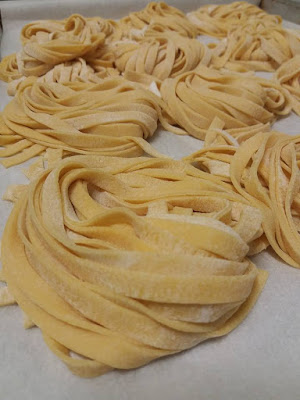This hands down is one of my favourite things to make, although I rarely do. Although it is simple to make, it is a tedious process which results in a sense of occasion. I normally set aside at least half a day to make it, especially when making my own lasange sheets. I always make more than required as it is always nice to have left-overs, especially when it has taken so much effort!
As discussed in my "ragu alla bolognese' recipe, there are many different ingredients that can be added- no two recipes are the same. I have tasted different varieties of lasagne where various cheeses have been used, such as ricotta and mozzarella (not the soapy variety we buy in Australian supermarkets). A friend's Sicilian grandmother used to add a thin layer of whisked eggs resulting in a creamy, rich texture. I like to keep mine simple, I have learnt in this instance "less is more"- a wise Italian woman taught me this!
The main four key fundamentals needed are: meat sauce, bechamel sauce, pasta sheets, parmesan cheese.
Invite your best friends over to share in the fruits of your labour!
What you will need (this will make two large lasagne trays):
1: Bolongese sauce (refer to recipe)
2: Bechamel sauce (refer to recipe)
3: Make fresh pasta sheets (refer to recipe), or buy fresh pasta sheets (about 700g)
4: 250g finely grated FRESH parmesan cheese (you can ask your local deli to grate for you)
How to make:
1: Make the meat sauce first, set aside
2: Make the bechamel sauce, set aside (if it becomes too thick add a little milk)
3: Cook the pasta sheets in salted boiling water, remove and place on tea-towel
4: Spread a thin layer of meat sauce in large tray, cover with pasta sheets and cut to size, spread pasta sheet with bechemel sauce, sprinkle generously with grated Parmesan cheese
5: Repeat this process until you have used all of the ingredients. There should be 4-5 layers of pasta. Top the final layer of pasta with a generous amount of bechamel sauce and grated parmesan cheese.
5: Cover with tin foil and place in the fridge (leave overnight to enhance flavour)
6: Cook in a pre-heated 180 degrees oven for 1/2 hour, remove foil and cook a further 10 minuets until golden.
Buon apetito!






















